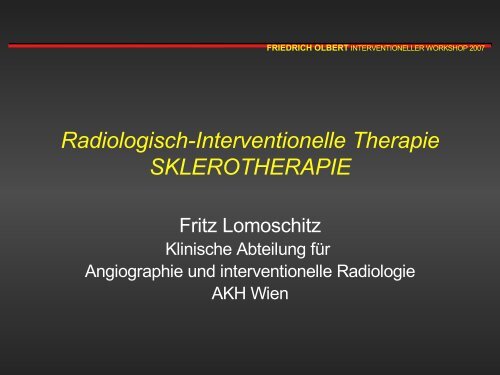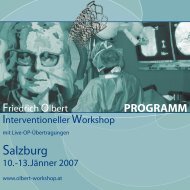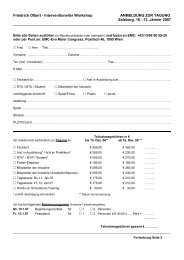Perkutane Sklerotherapie - olbert-workshop
Perkutane Sklerotherapie - olbert-workshop
Perkutane Sklerotherapie - olbert-workshop
Erfolgreiche ePaper selbst erstellen
Machen Sie aus Ihren PDF Publikationen ein blätterbares Flipbook mit unserer einzigartigen Google optimierten e-Paper Software.
FRIEDRICH OLBERT INTERVENTIONELLER WORKSHOP 2007<br />
Radiologisch-Interventionelle Therapie<br />
SKLEROTHERAPIE<br />
Fritz Lomoschitz<br />
Klinische Abteilung für<br />
Angiographie und interventionelle Radiologie<br />
AKH Wien
SKLEROTHERAPIE - Überblick<br />
• Einleitung<br />
• Bildgebende Diagnostik<br />
• Substanzen<br />
• Technik<br />
• Nachbehandlung<br />
FRIEDRICH OLBERT INTERVENTIONELLER WORKSHOP 2007
G.R., m, *02.04.2001, Venöse Malformation<br />
präSKLERO<br />
R.G., VM<br />
FRIEDRICH OLBERT INTERVENTIONELLER WORKSHOP 2007<br />
26.4.2005 6.6.2005 4.7.2005
G.R., m, *02.04.2001, Sklerosierung 21.04.2005<br />
präSKLERO<br />
R.G., VM<br />
FRIEDRICH OLBERT INTERVENTIONELLER WORKSHOP 2007<br />
26.4.2005 6.6.2005 4.7.2005
FRIEDRICH OLBERT INTERVENTIONELLER WORKSHOP 2007<br />
Two episodes of cardiac arrest in a boy receiving sclerotherapy with<br />
polydocanol--a case report<br />
[Article in Japanese] Masui. 2005 Jan;54(1):57-9<br />
Shimo T, Hidaka K, Yanagawa S, Kadota W, Kawakami S, Tsuchida H.<br />
Department of Anesthesiology, Kanazawa Medical University, Ishikawa<br />
920-0293.<br />
A 4-year-old boy, weighing 15.6 kg, experienced two episodes of cardiac<br />
arrest during the eight sessions of sclerotherapy under general<br />
anesthesia. Although cardiac arrest had been documented after<br />
accidental extubation during the seventh procedure, the specific cause<br />
had not been identified. For the eighth procedure, anesthesia was again<br />
induced and maintained with nitrous oxide and sevoflurane. A total of 10<br />
ml of 3% polydocanol was injected. Approximately five minutes after the<br />
injection, his heart rate slowed and asystole developed. External cardiac<br />
massage was started immediately and atropine was injected<br />
intravenously. His heart started to beat again very soon. From the clinical<br />
course, the two episodes of cardiac arrest could be attributable to<br />
polydocanol overdose. It was concluded that severe circulatory<br />
derangement might follow an injection of polydocanol during<br />
sclerotherapy.
SKLEROTHERAPIE<br />
EINLEITUNG<br />
FRIEDRICH OLBERT INTERVENTIONELLER WORKSHOP 2007
Interdisziplinäres Team<br />
Plastische Chirurgie<br />
HNO<br />
Angiologie<br />
Dermatologie<br />
Pädiatrie<br />
Anästhesie<br />
Pathologie<br />
Radiologie<br />
FRIEDRICH OLBERT INTERVENTIONELLER WORKSHOP 2007<br />
H. Kubiena<br />
M. Frey<br />
E. Frey<br />
J. Rokka<br />
C. Mädel<br />
S. Burjak<br />
H. Maier<br />
M. Burian<br />
J. Kettenbach<br />
K. Kienreich<br />
S. Kreuzer<br />
J. Lammer<br />
C. Loewe<br />
F. Lomoschitz<br />
T. Rand<br />
M. Schoder<br />
A. Stadler<br />
M. Gschwandtner<br />
A. Willfort<br />
A. Koller<br />
G. Amman<br />
…….
VASKULÄRE ANOMALIEN<br />
“Biologische” Klassifikation nach Mulliken+Glowacki<br />
Basiert:<br />
- Klinischer Verlauf<br />
- Histologie<br />
2 Gruppen:<br />
Tumore (u.a. Hämangiome)<br />
Ätiologie: Endothelzellproliferation<br />
Vaskuläre Malformationen<br />
FRIEDRICH OLBERT INTERVENTIONELLER WORKSHOP 2007<br />
Ätiologie: Abnorm entwickelte Gefäße<br />
Mulliken JB, Glowacki J.<br />
Hemangiomas and vascular malformations in infants and<br />
children: a classification based on endothelial charcteristics.<br />
Plast Reconstr Surg 1982;69:412-420
VASKULÄRE ANOMALIEN<br />
“Biologische” Klassifikation nach Mulliken+Glowacki<br />
Basiert:<br />
- Klinischem Verlauf<br />
- Histologie<br />
2 Gruppen:<br />
Tumore (u.a. Hämangiome)<br />
Ätiologie: Endothelzellproliferation<br />
Vaskuläre Malformationen<br />
FRIEDRICH OLBERT INTERVENTIONELLER WORKSHOP 2007<br />
Ätiologie: Abnorm geformte Gefäße<br />
Mulliken JB, Glowacki J.<br />
Hemangiomas and vascular malformations in infants and<br />
children: a classification based on endothelial charcteristics.<br />
Plast Reconstr Surg 1982;69:412-420
Vaskuläre Malformationen - Einteilung<br />
Histologie:<br />
Kapillär<br />
Lymphatisch<br />
Venös<br />
Arteriell<br />
Gemischt<br />
FRIEDRICH OLBERT INTERVENTIONELLER WORKSHOP 2007<br />
Flußgeschwindigkeit:<br />
Low-Flow<br />
High-Flow
Vaskuläre Malformationen - Einteilung<br />
Histologie:<br />
Kapillär<br />
Lymphatisch<br />
Venös<br />
Arteriell<br />
Gemischt<br />
FRIEDRICH OLBERT INTERVENTIONELLER WORKSHOP 2007<br />
Flußgeschwindigkeit:<br />
Low-Flow<br />
High-Flow
Low-Flow Vaskuläre Malformationen – Therapie<br />
<strong>Perkutane</strong> <strong>Sklerotherapie</strong> - Prinzip<br />
FRIEDRICH OLBERT INTERVENTIONELLER WORKSHOP 2007<br />
Ersatz des langsam fließenden Blut bzw. statischen<br />
Lymphe durch Sklerosans<br />
Therapeutischer Mechanismus: Zerstörung des<br />
Endothels mit konsekutiver Entzündung - Thrombose<br />
- Fibrose
Low-Flow Vaskuläre Malformationen - Einteilung<br />
Kapilläre Malformationen<br />
Venöse Malfomationen (VM)<br />
Lymphatische Malformationen (LM)<br />
FRIEDRICH OLBERT INTERVENTIONELLER WORKSHOP 2007
Low-Flow Vaskuläre Malformationen - Einteilung<br />
Kapilläre Malformationen<br />
Venöse Malfomationen (VM)<br />
Lymphatische Malformationen (LM)<br />
FRIEDRICH OLBERT INTERVENTIONELLER WORKSHOP 2007
Venöse Malformationen - Morphologie<br />
Abnorme Entwicklung der<br />
Venenwand<br />
Kontraktion (z.B. nach körperl.<br />
Belastung) nicht möglich<br />
Dilatation, Schwellung,<br />
Thrombose, Schmerz<br />
Kontinuierlicher Wechsel von<br />
Thrombose und Thrombolyse<br />
FRIEDRICH OLBERT INTERVENTIONELLER WORKSHOP 2007
Venöse Malformationen - Klinik<br />
Typ. weich + komprimierbar<br />
Thromben und Phleboliten palpabel<br />
Haut nicht überwärmt, livide<br />
Symptome: Schwellung, Schmerz,<br />
Bewegungseinschränkung<br />
FRIEDRICH OLBERT INTERVENTIONELLER WORKSHOP 2007
Venöse Malformationen - Einteilung<br />
Fokal<br />
Multifokal<br />
Diffus<br />
FRIEDRICH OLBERT INTERVENTIONELLER WORKSHOP 2007
Lymphatische Malformationen - Morphologie<br />
Abnorme Entwicklung der Lymphgefäße<br />
Intermittierende Schwellung<br />
- oft Infekt-assoziiert<br />
- unabhängig von Bewegung / Valsalva<br />
Häufige Kombination mit:<br />
- kutanen kapillären Malformationen<br />
- venösen Ektasien (ohne Shunt)<br />
FRIEDRICH OLBERT INTERVENTIONELLER WORKSHOP 2007
Lymphatische Malformationen - Einteilung<br />
Mikrozystisch<br />
(zystische Komponente < 2cm)<br />
Makrozystisch<br />
(gehäuft: Hals, Axilla, Becken)<br />
Gemischt<br />
FRIEDRICH OLBERT INTERVENTIONELLER WORKSHOP 2007
SKLEROTHERAPIE<br />
FRIEDRICH OLBERT INTERVENTIONELLER WORKSHOP 2007<br />
BILDGEBENDE DIAGNOSTIK
Bildgebende Diagnostik<br />
Praeinterventionell:<br />
MRI<br />
Periinterventionell:<br />
Sonographie, Durchleuchtung<br />
Postinterventionell:<br />
MRI<br />
FRIEDRICH OLBERT INTERVENTIONELLER WORKSHOP 2007
Venöse Malformation; w, 11a<br />
PRAE<br />
PERI<br />
FRIEDRICH OLBERT INTERVENTIONELLER WORKSHOP 2007<br />
POST
Venöse Malformation; m, 9a<br />
PRAE<br />
PERI<br />
FRIEDRICH OLBERT INTERVENTIONELLER WORKSHOP 2007<br />
POST
MIYABI<br />
FRIEDRICH OLBERT INTERVENTIONELLER WORKSHOP 2007
MIYABI<br />
FRIEDRICH OLBERT INTERVENTIONELLER WORKSHOP 2007
Lymphatische Malformation; m, 17a<br />
PRAE<br />
FRIEDRICH OLBERT INTERVENTIONELLER WORKSHOP 2007<br />
POST
SKLEROTHERAPIE<br />
SUBSTANZEN<br />
FRIEDRICH OLBERT INTERVENTIONELLER WORKSHOP 2007
<strong>Perkutane</strong> <strong>Sklerotherapie</strong> - Substanzen<br />
Venöse Malformation<br />
• Ethanol<br />
• Polidocanol<br />
• Ethanolamin<br />
• Ethibloc<br />
• STS (Sodratecol /<br />
Sodiumtetradecylsulfat)<br />
• OK-432<br />
FRIEDRICH OLBERT INTERVENTIONELLER WORKSHOP 2007<br />
Lymphatische Malformation<br />
• Ethanol<br />
• Polidocanol<br />
• Ethanolamin<br />
• Ethibloc<br />
• STS (Sodratecol /<br />
Sodiumtetradecylsulfat)<br />
• OK-432<br />
• Doxycyclin<br />
• Bleomycin Trend
Ethanol<br />
• 95-98% (“absolutes”) Ethanol<br />
FRIEDRICH OLBERT INTERVENTIONELLER WORKSHOP 2007<br />
• Hochwirksames (i.e. aggressives!!) Sklerosans<br />
• Sofortige Denaturierung endothelialer Zellproteine<br />
> Zerstörung des Endothels > Thrombose<br />
• CAVE! Transmurale Gefäßnekrose durch Diffusion<br />
• Effektivstes Sklerosans (Ind.: Ausgedehnte VM)<br />
• daher auch ernste Nebenwirkungen
Ethanol<br />
FRIEDRICH OLBERT INTERVENTIONELLER WORKSHOP 2007<br />
Nebenwirkungen (10-30%)<br />
• Schwellung<br />
Cave! Kompartmentsyndrom, Atemwege<br />
• Nekrosen (-15%)<br />
• Neurolyse - Periphere Nervenschädigung (-10%)<br />
• Zentrale Dämpfung – Koma<br />
• Hypoglykämie<br />
• Hämolyse - Hämoglobinurie<br />
• Hyperthermie<br />
• Hypertensive Krise<br />
• Kardiale Arrhytmien
Ethanol<br />
Applikation<br />
• Anästhesie + ICU (i.e. stationär)<br />
• Vollnarkose / Vitalparameter<br />
• Hydratation<br />
FRIEDRICH OLBERT INTERVENTIONELLER WORKSHOP 2007<br />
• Maximaldosis 1ml/kg KG bzw. max. 60ml / Sitzung
<strong>Perkutane</strong> <strong>Sklerotherapie</strong><br />
Aufgrund Nebenwirkungen<br />
FRIEDRICH OLBERT INTERVENTIONELLER WORKSHOP 2007<br />
Trend zu anderen bzw. neuen Substanzen:<br />
Polidocanol<br />
Doxycyclin<br />
OK-432
Polidocanol<br />
Aethoxysklerol 2% (40mg) / 3% (60mg)<br />
FRIEDRICH OLBERT INTERVENTIONELLER WORKSHOP 2007<br />
Sklerosierende + lokalanästhetische Wirkung<br />
Endothelschädigung<br />
Zunächst antikoagulatorisch, anschließend<br />
Thrombusbildung über 7d<br />
Kompressionsverband – minimiert Rekanalisation des<br />
organisierenden Thrombus<br />
Maximaldosis 2mg/kg KG
Doxycyclin<br />
• Vibravenös 5ml / 100mg<br />
• Ad 10ml (NaCl / KM)<br />
• Lösung 10mg/ml<br />
FRIEDRICH OLBERT INTERVENTIONELLER WORKSHOP 2007<br />
• Besonders für ausgedehnte makrozystische LM da<br />
verabreichbare Menge höher<br />
• KI: Überempfindlichkeit gegen Tetracyline
OK-432<br />
FRIEDRICH OLBERT INTERVENTIONELLER WORKSHOP 2007<br />
• Abgetötete Streptokokken (Streptococcus<br />
pyogenes) in Penicillin-hältiger Lösung<br />
• Japan, Europa; in USA dzt. nicht zugelassen<br />
• Entzündungsreaktion über Cytokinaktivierung (IL,<br />
Interferone, TNF) + Zystenschrumpfung<br />
• Pulverform 0,1mg<br />
• Lösung mit NaCl (+ KM)<br />
• Maximaldosis / Behandlung: 0,2mg<br />
• NW: minimal, vglw. geringe Schwellung<br />
• Sehr effektiv bei makrozystischen LM (80-90%)
SKLEROTHERAPIE<br />
TECHNIK<br />
FRIEDRICH OLBERT INTERVENTIONELLER WORKSHOP 2007
<strong>Perkutane</strong> Sklerosierung - Technik<br />
Anästhesie<br />
regional bei kleinen Veränderungen<br />
FRIEDRICH OLBERT INTERVENTIONELLER WORKSHOP 2007<br />
Vollnarkose bei ausgedehnten Veränderungen,<br />
Ethanol, Kindern
<strong>Perkutane</strong> Sklerosierung - Technik<br />
Bei ausgedehnten Veränderungen<br />
an der Extremität:<br />
Bein horizontal bzw. 30°angehoben<br />
Stauung infrasystolisch<br />
Kompressionsverband<br />
FRIEDRICH OLBERT INTERVENTIONELLER WORKSHOP 2007
<strong>Perkutane</strong> Sklerosierung - Technik<br />
FRIEDRICH OLBERT INTERVENTIONELLER WORKSHOP 2007<br />
Direkte Punktion (palp. bzw. sonographisch gezielt)
<strong>Perkutane</strong> Sklerosierung - Technik<br />
Suspension + KM (~1:10 - 1:20)<br />
Durchleuchtungsgezielte Applikation<br />
FRIEDRICH OLBERT INTERVENTIONELLER WORKSHOP 2007
SKLEROTHERAPIE<br />
NACHBEHANDLUNG<br />
FRIEDRICH OLBERT INTERVENTIONELLER WORKSHOP 2007
<strong>Perkutane</strong> <strong>Sklerotherapie</strong> - Nachbehandlung<br />
FRIEDRICH OLBERT INTERVENTIONELLER WORKSHOP 2007<br />
Kompressionsverband – minimiert Rekanalisation des<br />
organisierenden Thrombus
<strong>Perkutane</strong> <strong>Sklerotherapie</strong> - Nachbehandlung<br />
Cave: Schwellungen – Corticosteroide<br />
FRIEDRICH OLBERT INTERVENTIONELLER WORKSHOP 2007<br />
6h post Sklero (Aethoxysklerol)
<strong>Perkutane</strong> <strong>Sklerotherapie</strong> - Nachbehandlung<br />
FRIEDRICH OLBERT INTERVENTIONELLER WORKSHOP 2007<br />
Kompressionsverband – minimiert Rekanalisation des<br />
organisierenden Thrombus<br />
Cave: Schwellungen – Corticosteroide<br />
Bilanzierung:<br />
i.v. Flüssigkeit<br />
Harnausscheidung (Hämoglobinurie)
<strong>Perkutane</strong> <strong>Sklerotherapie</strong> - Nachbehandlung<br />
FRIEDRICH OLBERT INTERVENTIONELLER WORKSHOP 2007<br />
Kompressionsverband – minimiert Rekanalisation des<br />
organisierenden Thrombus<br />
Cave: Schwellungen – Corticosteroide<br />
Bilanzierung:<br />
i.v. Flüssigkeit<br />
Harnausscheidung (Hämoglobinurie)<br />
d.h. stationäre Observanz, Dauer abhängig von<br />
postinterventionellen Verlauf
Zusammenfassung according to Patricia Burrows:<br />
FRIEDRICH OLBERT INTERVENTIONELLER WORKSHOP 2007<br />
“The treatment of low flow vascular malformations<br />
involves the performance of procedures that are<br />
relatively simple, technically, but often require<br />
careful planning and postprocedure monitoring and<br />
care to achieve optimal results and minimal<br />
complications…….<br />
….Most patients benefit clinically from these<br />
procedures…….<br />
….hope that, as knowledge about lesions increases,<br />
these techniques can be applied with biologic<br />
agents that are more disease-specific and less<br />
toxic to the tissues.<br />
Patricia E. Burrows, Interventional Radiologist, Harvard Medical School






